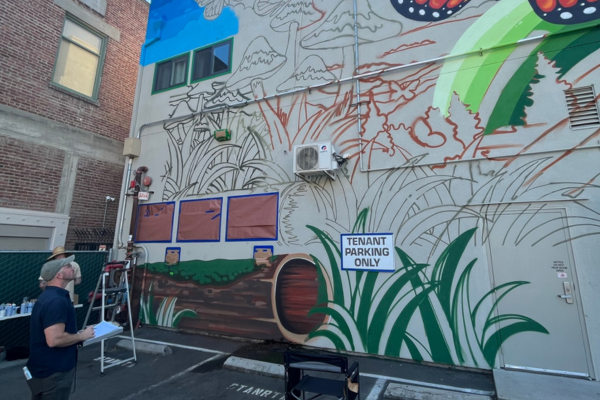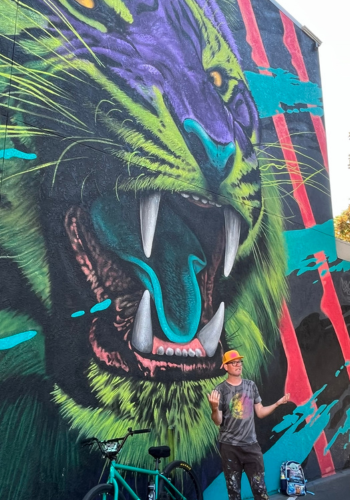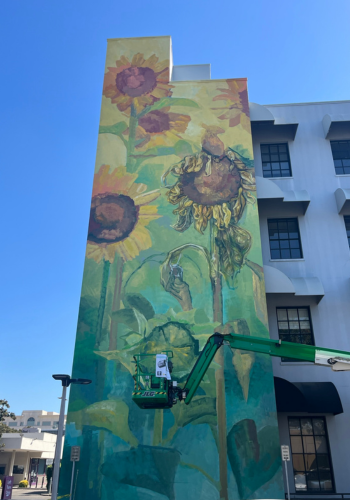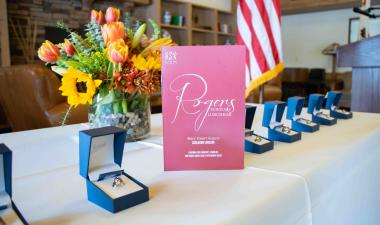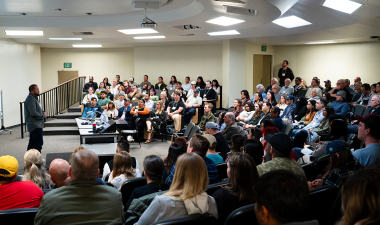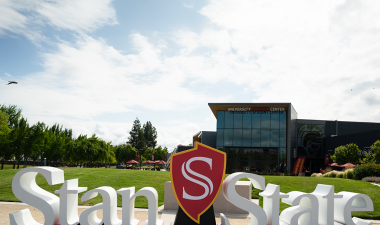Alexander Ayers didn’t expect to be published.
The Stanislaus State student just wanted to experience the academic peer-review process. But with faculty mentorship and fieldwork experience behind him, an article he co-authored with Professor of Geography Jennifer Helzer, which focused on the city of Modesto’s public murals, found a home in “California Geography,” the journal of the California Geographical Society.
The article, “Out of the Fog: Tracing Image and Identity in Modesto’s Murals,” explores how murals across downtown Modesto tell stories — from the region’s deep agricultural roots to its nostalgic car culture and its push toward a more global, creative identity. Drawing from cultural geography, Ayers and Helzer examined how public art reflects a community’s pride while also raising questions about identity, growth and the way cities reshape themselves over time.
A native of Gustine, Ayers is in his final semester at Stanislaus State, where he is completing a double major in geography and philosophy.
Ayers’ published article debuts just ahead of the 79th Annual California Geographical Society Conference, which Stanislaus State will host for the first time. The conference, which brings geography students and faculty from across the state to share research and explore the local region, will take place Friday, April 25, through Sunday, April 27, at the University’s main campus in Turlock.
“I had the privilege of having this project introduced to me by Professor Helzer,” Ayers said. “It was nice to walk around Modesto with no concrete aim beyond ‘find murals and take them in.’ I grew up in an area that is predominantly Hispanic, and so the muralismo tradition has always been present. Silent, but present.”
The journal article originated from the course GEOG 4710 – Field Methods, a class that blends fieldwork, theory and applied research. As part of the class, students surveyed murals across downtown Modesto and looked at how location and design choices reflected deeper cultural themes. They worked collaboratively with the Modesto Downtown Improvement District and the Downtown Modesto Partnership, which shared background on the city’s mural initiatives.
“Upon completing this course, students are expected to become familiar with a range of field techniques used in geography and acquire foundational fieldwork and writing skills applicable in the workplace or graduate studies,” Helzer said. “The course emphasizes the research process, but a significant portion of most classes takes place in the field. Through hands-on exercises, students experience a variety of techniques that reinforce classroom concepts.”
Helzer said Ayers stood out early in the course for his initiative and thoughtfulness.
“What impressed me most about Alexander’s work on the mural study was his enthusiasm for fieldwork and his dedication to conducting a thorough content analysis of murals in Downtown Modesto,” Helzer said. “While the original class assignment asked students to sample murals from various locations, Alex went above and beyond. He documented all the murals through additional field research.”
The project ended with a paper in which Ayers analyzed where the murals were located and what messages or themes they expressed. That’s when, according to Helzer, Ayers’ strengths as a researcher and writer stood out.
“He is a gifted thinker and writer, and after reading his first draft, I encouraged him to pursue publication,” she said. “His work not only reflects the high caliber of undergraduate research at Stan State, but also the potential of our students to contribute meaningful scholarship to their communities.”
Ayers credits the support of Stan State faculty, especially in the Geography and Philosophy departments, for helping him grow as a scholar.
“Professor Helzer is an exceptional mentor,” Ayers said. “She navigates her courses with excitement, and beyond the classroom, she’s taken an active role in mentoring me through my graduate studies ambitions. One of her crowning skills is her ability to create social situations where people can network and collaborate, which is a domain I absolutely fail at.”
Helzer emphasized that community-based learning is a cornerstone of the geography and environmental resources program. Working with local partners such as the Downtown Modesto Partnership allows students to connect their research to real-world needs.
“In this case, we were able to share our findings with the organization, which used the data to update their murals map and marketing materials,” Helzer said. “These partnerships help build goodwill and support for the University by showcasing the high-quality work our students produce.
“For students, such collaborations offer real-world experience, help them develop professional skills and deepen their understanding of local community needs. In many cases, these partnerships lead to internships or career opportunities.”
Before returning to college, Ayers spent more than a decade touring as a musician and working internationally as a commercial seaman. He later lived in the Philippines, where he started a family, before deciding to come home to the Central Valley and finish his degree at Stanislaus State.
He was recently accepted into the Master of Fine Arts program in creative nonfiction at Fresno State and is submitting a proposal to the Stan State’s interdisciplinary studies M.A. program to develop a textbook on introductory geophilosophy.
Helzer said experiences such as getting published, participating in conference presentations and doing fieldwork all play critical roles in preparing students to thrive after graduation.
“We strive to provide every geography and environmental resources major with a high-quality education that builds both professional and communication skills,” Helzer said. “These experiences prepare our students not only to succeed after graduation, but also to make meaningful contributions to their communities.”
As he prepares to graduate in May, Ayers hopes projects like this inspire more students to explore their own questions through research and recognize that their voices matter.
“There are a lot of brilliant individuals in the student body at Stan State, and I would love to see more of them reach out and take chances within the relatively safe space of academia,” he said. “Don’t wait for permission to explore. Go out and do it.”
With graduate school on the horizon, Ayers is looking ahead while staying grounded in the region that shaped him.
“I wanted to take my lessons and earned experiences abroad and use them to engage more wholly with my childhood home,” Ayers said. “Community-based projects are more essential than I think is commonly discussed. And what better medium than public art and muralism?”

